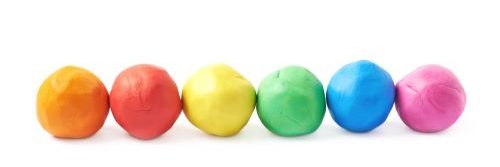In this article, you will learn what Montessori math materials are and when they are introduced. This information can be helpful to parents who are interested in implementing Montessori homeschooling for the primary age group (2.5-6).
Learning about Montessori math materials can also be helpful to parents and caregivers with children enrolled in a Montessori program.
Understanding the concept of Montessori math materials and the sequence in which they are introduced can be comforting to parents wondering how and when their child will be introduced to the different math concepts.
- What are Montessori math materials?
- List of Montessori math materials by the age
- Number Rods
- Sandpaper Numbers
- Spindle Boxes
- Numbers and Counters
- Golden Bead Material
- Number Cards
- Stamp Game
- Equation Slips
- Dot Game
- Colored Bead Bars
- Tens and Teens Boards
- Teen Frame
- Hundred Board
- Small Number Rods
- Strip Boards
- Math Charts
- Bead Boards
- Frequently asked questions
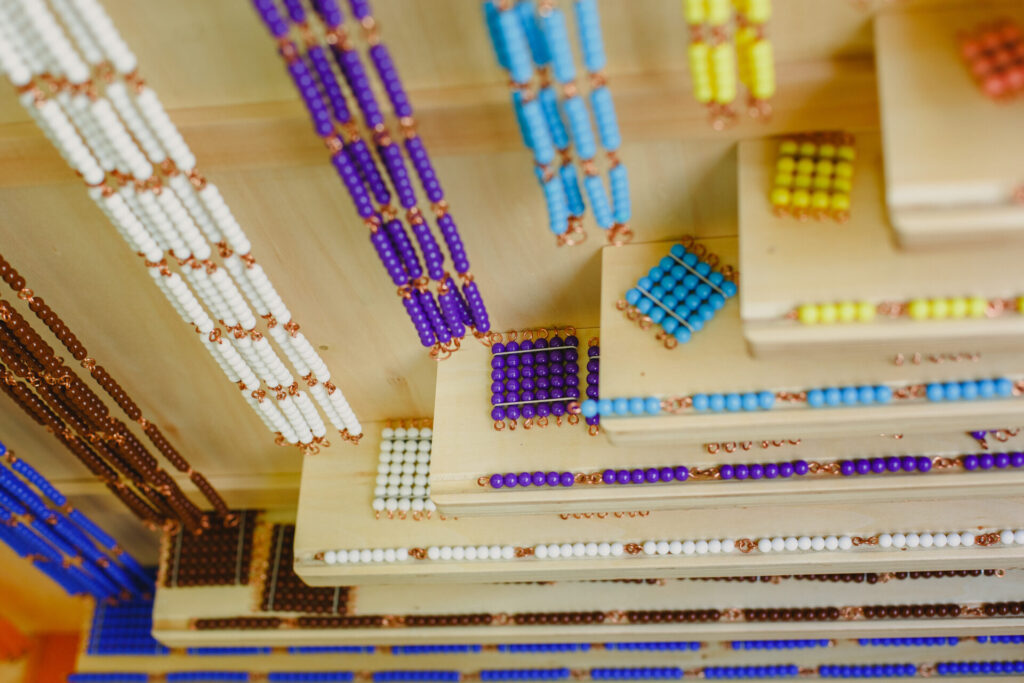
What are Montessori math materials?
Montessori math materials are designed to develop a young child's mathematical mind.
These materials introduce mathematical concepts in order of concrete to abstract; starting with tactile impressions of quantities and progressing to memorization.
Prior to the introduction of math materials, children have spent time working with sensorial, Practical Life, culture and science, and some language arts materials and activities.
In fact, math materials are not generally introduced to children until a child's second year in primary.
Skills refined through the first year of a Montessori primary program are necessary for a child to be successful with the second and third year's math.
Montessori math materials and activities themselves are introduced in careful order, as well.
Characteristics of Montessori math materials:
- control of error
- pleasing to look at
- consistent
- move from concrete to abstract
- move from simple to complex
- made for children to manipulate
- designed for a specific function
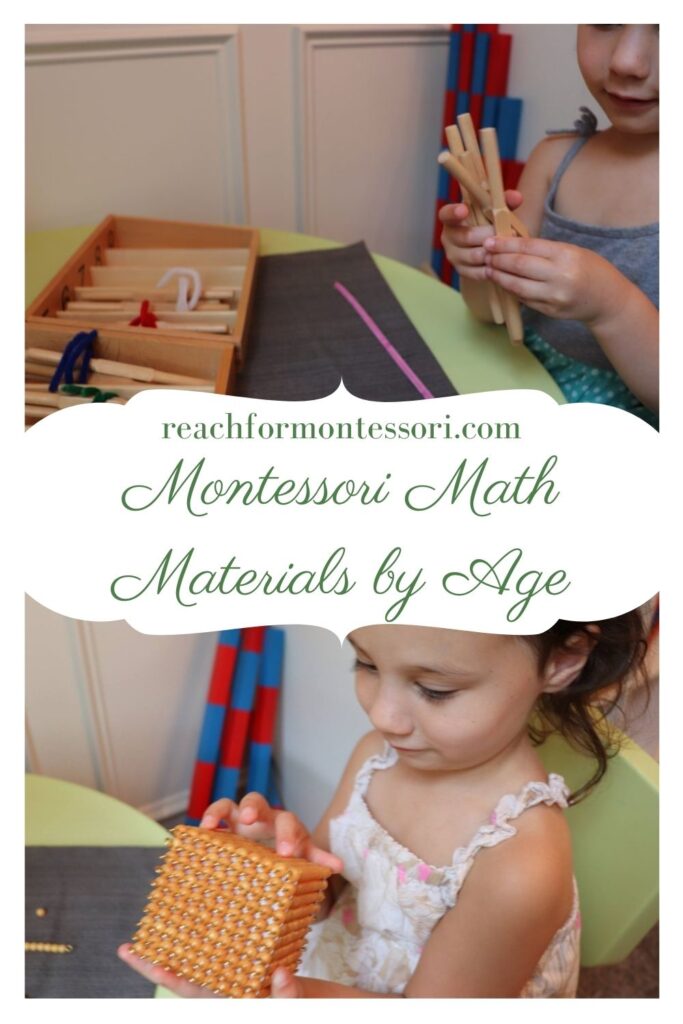
(This post contains affiliate links. Purchasing from these links costs you nothing extra, but sends a few cents our way for website upkeep.)
List of Montessori math materials by the age
This is a list of standard Montessori math materials. Many Montessori schools utilize various math boards and grids, such as Insta-Learn boards.
This list is great for Montessori homeschooling or if you are looking to supplement your preschool classroom's traditional curriculum.
Number Rods
- 4 years old
- The Number Rods are wooden rods that match the dimension of the Long Red Rods, a sensorial material. The difference in this Montessori material is the rods are painted red and blue in alternating segments. This is the first material a child will work with that associates quantities with written numbers.
- It consists of 10 wooden corner bars from 1 to 10, the size of…
- peration method: 1. Place the rods on the rug on one side of the…
- The second show: the three-stage teaching method teaches children…
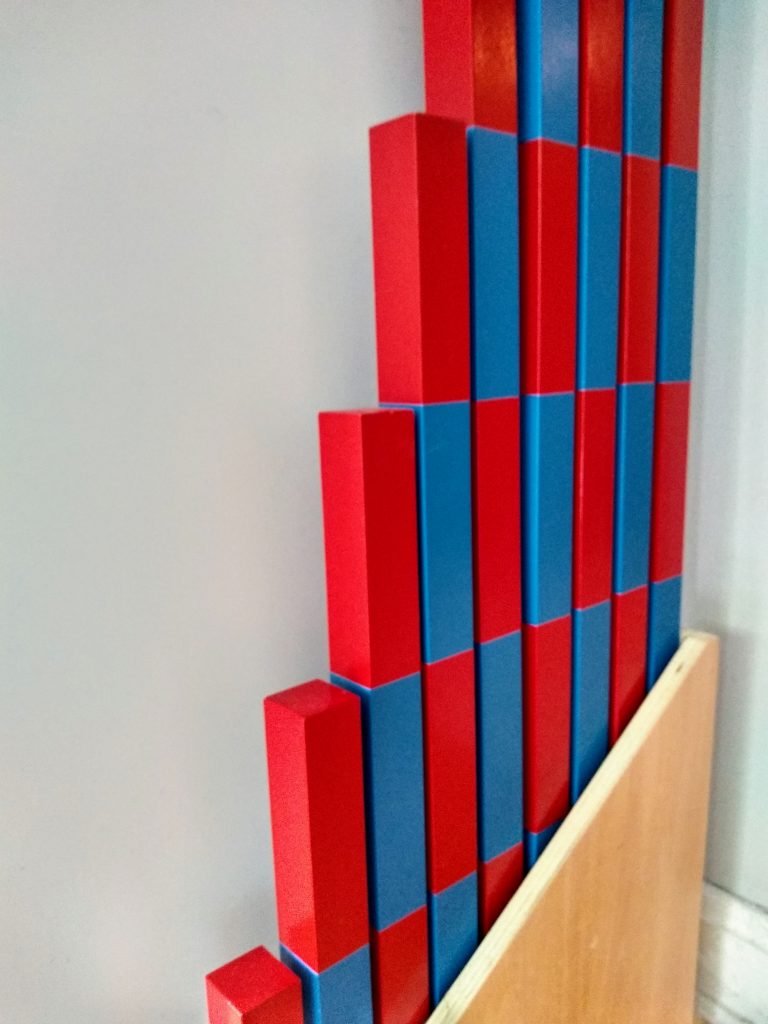
Sandpaper Numbers
- 4 years old
- Similar to Sandpaper Letters, Sandpaper Numbers are rough symbols on smooth cards. This material is designed to give children a sensorial impression of written numbers.
- Two wooden boxes of five compartments each with the numerals 0-9…
- Purpose: Understand the 1-9 number, numbers, names corresponding…
- Purpose: Understand the concept of 0; perception is empty.
Spindle Boxes
- 4.5 years old
- The Spindle Boxes are 2 partitioned boxes containing wooden dowels. This is designed to give children a muscular impression of the quantities, as they collect and bind them to place in each section.
Numbers and Counters
- 4.5 years old
- The Numbers and Counters math material consists of small plastic numbers and wooden counters. Through activities with this material, children gain a deeper understanding between quantities and their written representations, sequence, and are introduced to the visual concept of odd and even.
- Montessori Cards & Counters Mathematics Teaching Materials,…
- Help children understand the concept of odd number and even…
- Intuitively observe the corresponding relationship between…
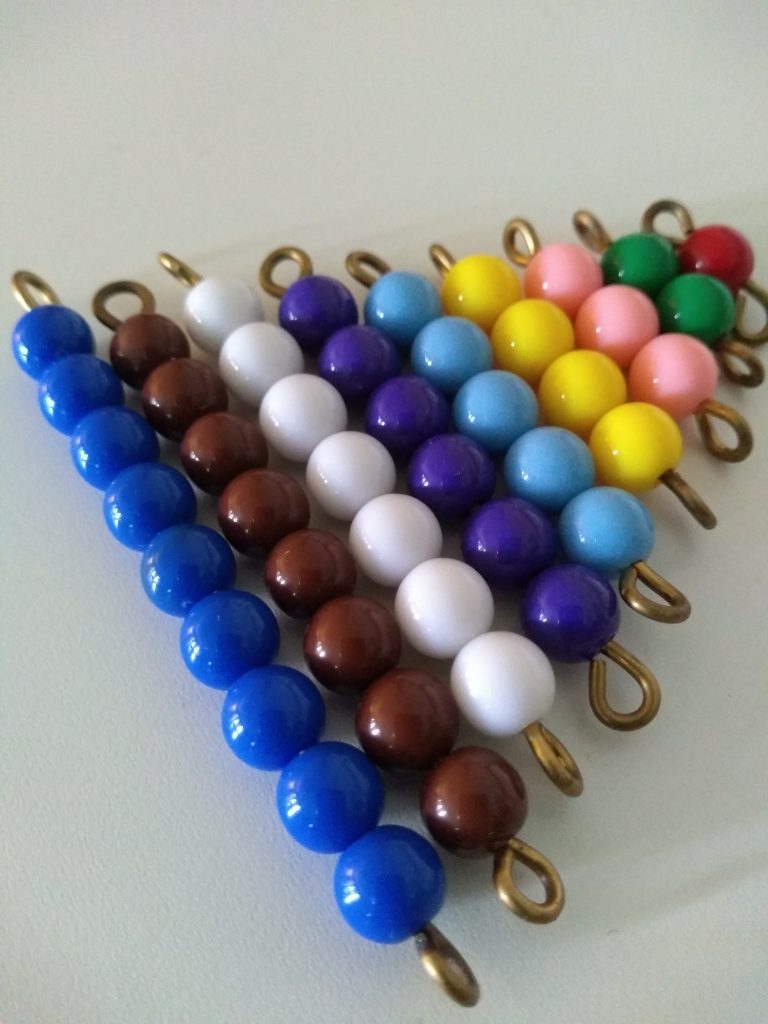
Golden Bead Material
- 4.5-6 years old
- This material consists of tiny gold-colored beads that represent a unit, 10, 100, and 1000. The Golden Bead Material is used extensively throughout the math curriculum and is often used in conjunction with other math materials.
- 🌱The Golden Bead Material introduces a group of children to…
- 🌱The set contains: 100 golden bead units with a wooden tray,…
- 🌱The set also includes: 9 wooden cubes of 1000, 3 wooden…
Number Cards
- 4.5-5 years old
- The large and small number cards are small, color-coded wooden cards. They are used with the Golden Bead Material and are stacked/unstacked to compose/decompose large numbers.
- 🌱The purpose of this material is to demonstrate to the child…
- 🌱Item includes Small Number Cards 1 to 9000 Wood, displayed in…
- 🌱The smallest numbers, 1 – 9, are referred to as…
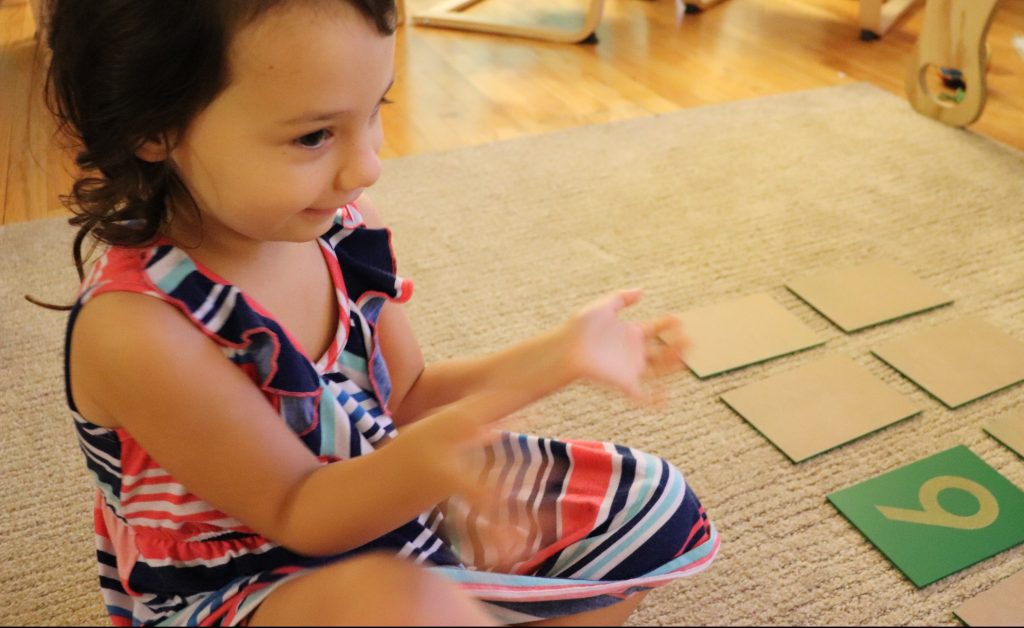
Stamp Game
- 4.5-5 years old
- This material reinforces the math concepts from work with the Golden Bead material. Instead of beads, a child designs equations using colored-coded numbered tiles.
- 【Enhances Early Math Skills】: This Montessori Stamp Game…
- 【Complete Set for Engaging Learning】: The game comes in a…
- 【High-Quality Wooden Construction】: Made from durable beech…
Equation Slips
- 4.5-5 years old
- Introduced with the Stamp Game, these cards have an equation on one side and the answer on the other side, allowing children to work with numerous math materials independently.
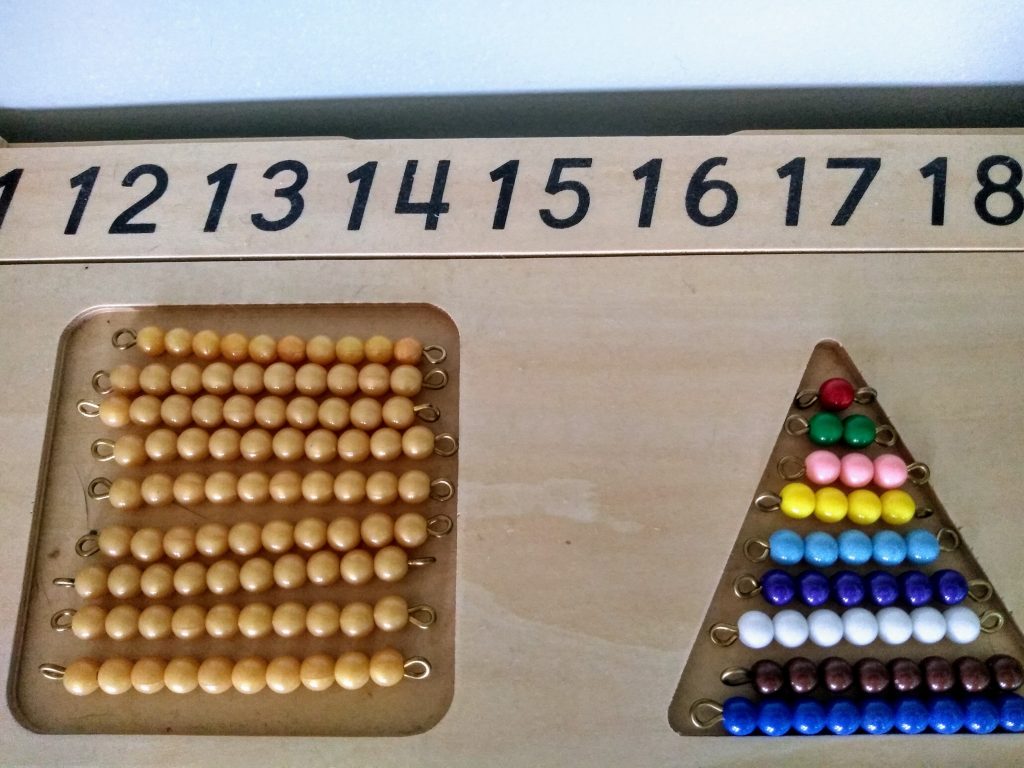
Dot Game
- 5 years old
- This is a dry erase board (it is sometimes presented on paper) with a color-coded grid. Instead of using hands-on materials, children draw dots in the proper column. This material/activity introduces the concept of “carrying”.
Colored Bead Bars
- 4.5 years old
- Colored beads are linked together to form the quantities 0-9. Used for addition and subtraction games, such as the Snake Game, and also in conjunction with the Golden Bead material.
- 5 sets of colored bead bars for the numbers 1-9. For addition,…
- Recommended Ages: 4 years and up
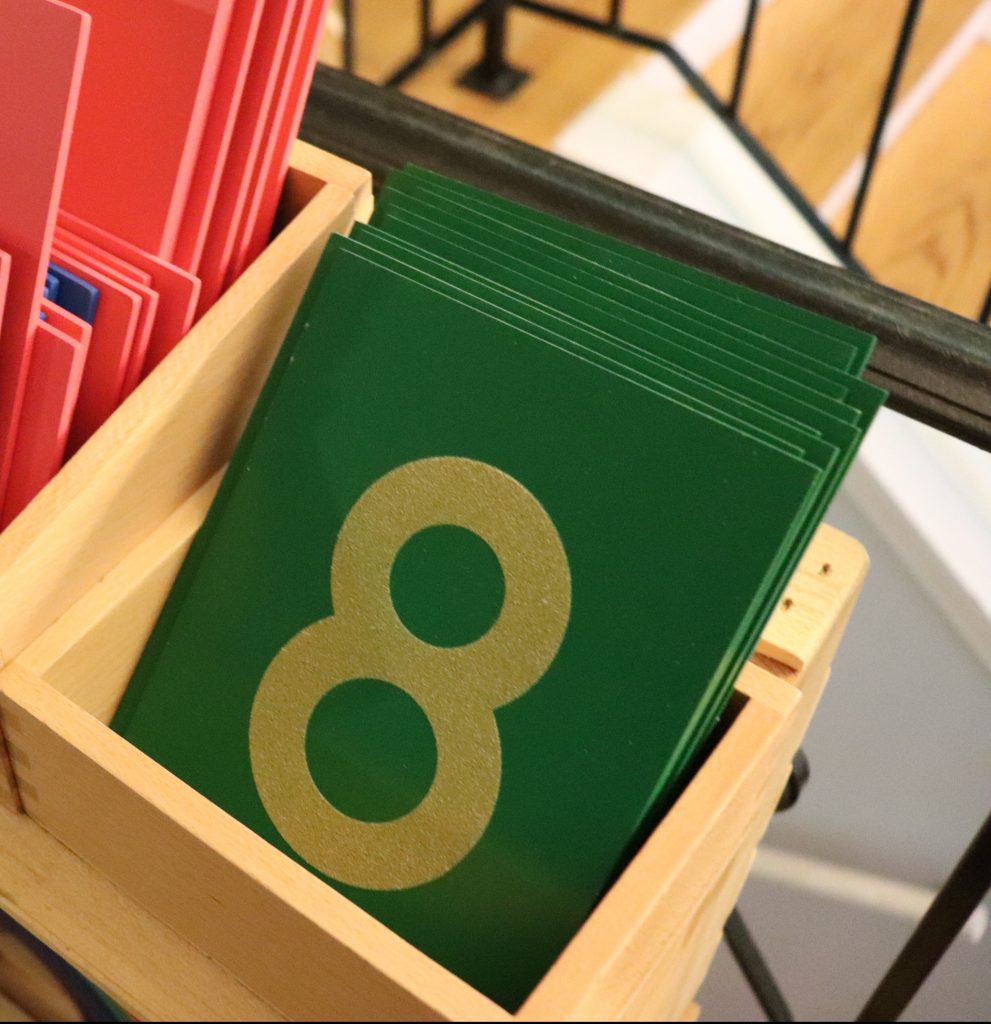
Tens and Teens Boards
- 4.5-5 years old
- Used with Golden Bead material and Short Bead Stair to introduce the names of the symbols that correspond to the quantities 11-99.
- Montessori Math Materil: Teens & Tens Board
- Early Math Material,Counting 1-100,usually used with montessori…
- This size is for family teaching,not standard version.2.56″x…
Teen Frame
- 4.5-5 years old
- This material consists of a wooden frame with metal hooks for hanging beads in sequence. 10 Golden Bead chains are presented along with a short bead stair.
- 🌱Wooden hanger for teen bead with small tiles 11 to 19.
- 🌱Includes 9 golden beads of ten
- 🌱Includes 1 to 9 Colored bead Stairs
Hundred Board
- 4.5-5 years old
- The Hundred Board is a wooden board and numbered tiles (1-100). This Montessori math material. This material is for sequencing mastery.
- One- hundred Framed blue wooden board with 100 squares. A wooden…
- A cover boxed printed figure 1-100 100 square plate.
- The box is divided into two cells, each cell is loaded 50.
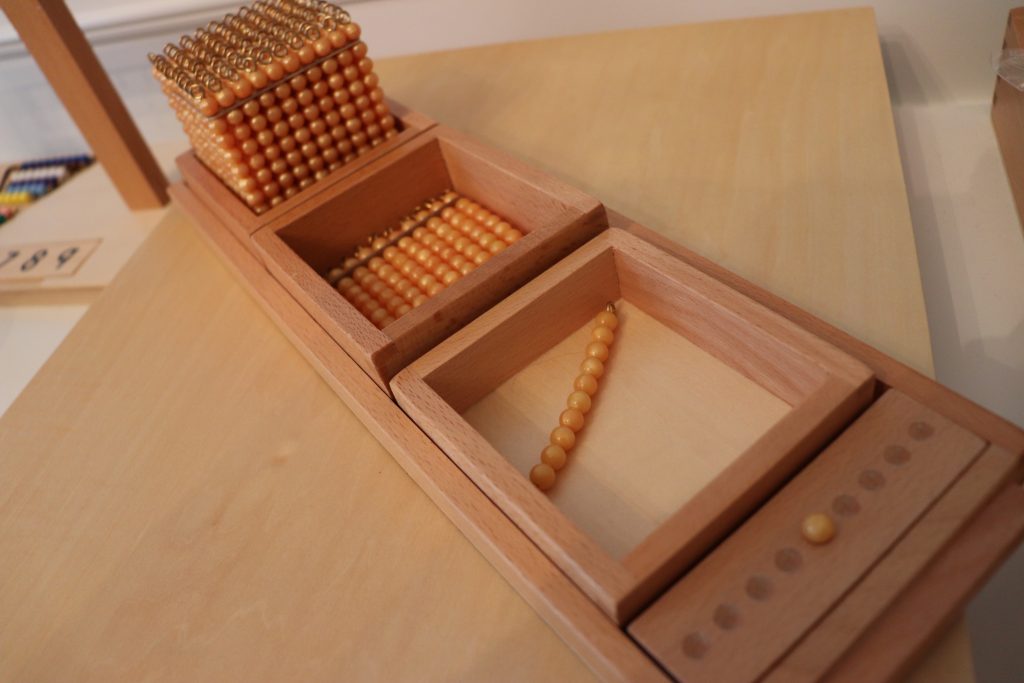
Small Number Rods
- 4.5-5 years old
- This material is similar to the regular number rods, but is much smaller and has 2 sets of rods instead of one; a control set and a working set. Children practice addition and subtraction with this material.
- Montessori Math Mathematics Teaching Materials Numerical Rods,…
- Through the sense of touch and vision, help children to have a…
- Help children to establish the concept of order and the…
Strip Boards
- 5-6 years old
- These boards are presented with 2 sets of colored strips. Children place the strips in the boards to form an equation, then check their answers using the numbers at the top of the boards.
- COMMODITY COMPOSITION: addition board (blue grid) and reverse…
- DIRECT PURPOSE:Montessori Addition and Subtraction Board,through…
- INDIRECT PURPOSE:Prepare for primary school mathematics study and…
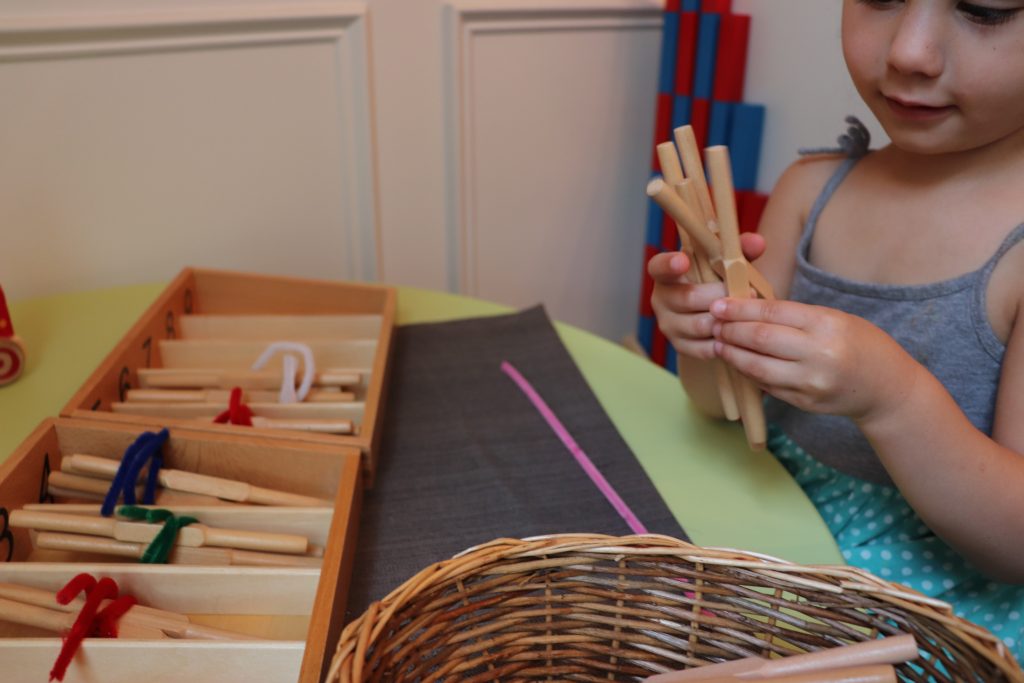
Math Charts
- 5-6 years old
- Each mathematical operation has a series of charts designed to aid in the memorization of math facts.
- Used in math activities to help kids understanding the Addition…
- The Addition Working Charts could stimulate children's interest…
- Excellent homeschool or classroom early educational material,…
Bead Boards
- 5-6 years old
- This material is a square wooden board with small indents that form rows and columns of ten. Children experience the composition of different equations through this material.
- Montessori mathematics teaching material addition subtraction…
- Montessori mathematics teaching aids, through intuitive display…
- Prepare for primary school mathematics study and cultivate…
There is so much to say about each of these materials and each has or will have its own explanation and presentation in a separate post.
Watching a child develop a deep understanding of math through these items is truly amazing.
What is your child's favorite Montessori math material?
Cheers and don't forget to subscribe!
Frequently asked questions
Math is taught in Montessori in the order of concrete to abstract. Children are first introduced to tangible quantities and their audible names.
Throughout the Montessori math lessons, children are introduced to more and more abstraction. For example, after a child is familiar with the quantities up to 10, they will be introduced to the written numerals, as those are an abstract representation of the quantities.
After some time, when children are ready, they will be working with written numbers only.
It's not entirely necessary to have Montessori math materials in your home in order to learn math the Montessori way.
Since Montessori teaches math starting with manipulatives, all you need for very early math lessons at home is small items in a large quantity. The items should be consistent in appearance, size, and shape.
Beans, raisins, beads, and other items can be used by themselves, then along with number cards later on when the child is ready.
The short answer to this question is “yes”. Montessori math has proven to be an effective way of learning math.
It shares many similarities with Common Core math standards, which teach children to experiment and find different ways of coming to mathematical solutions. This increases a child's understanding of quantities and equations, as well as their enjoyment of math.
